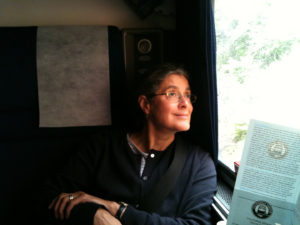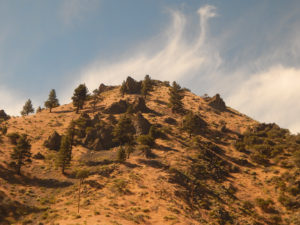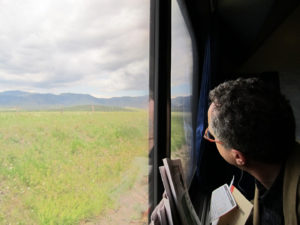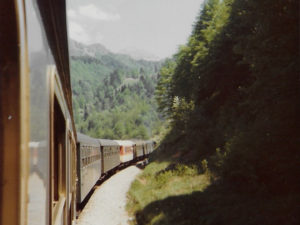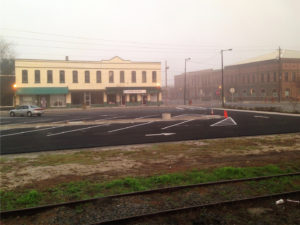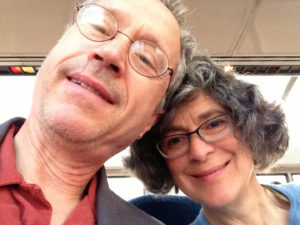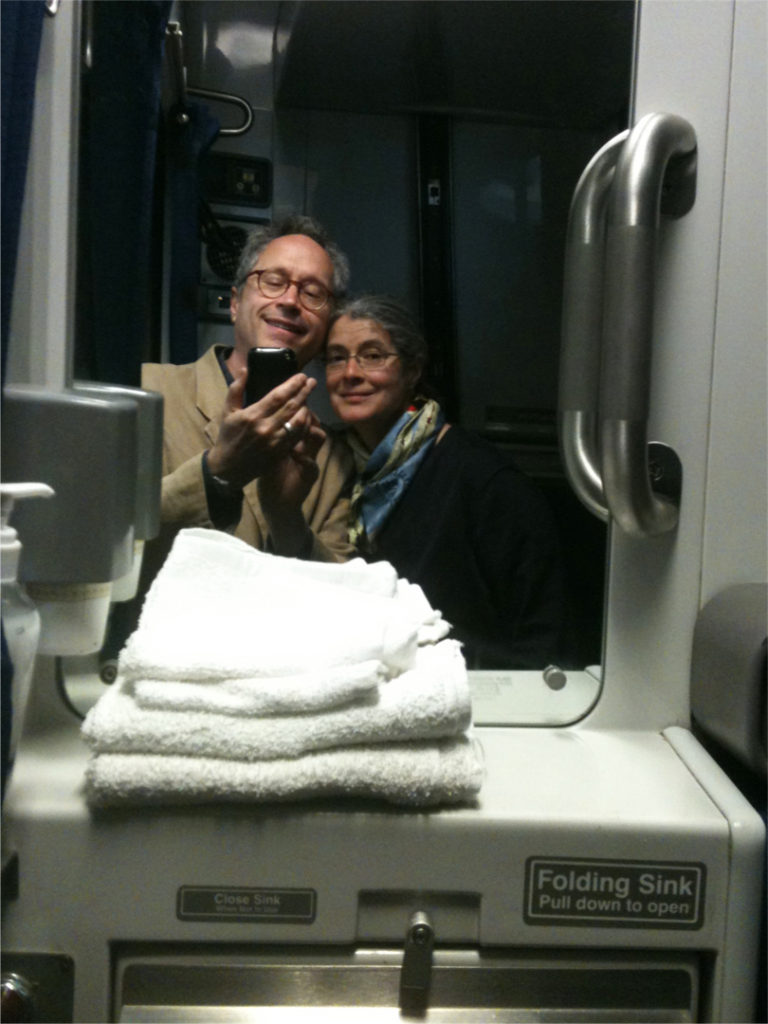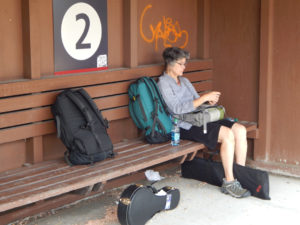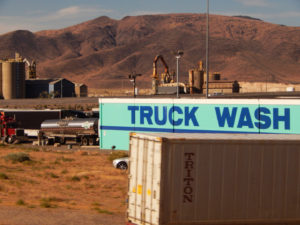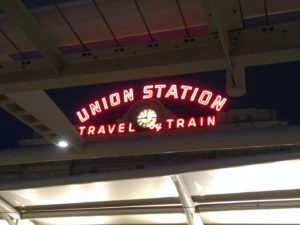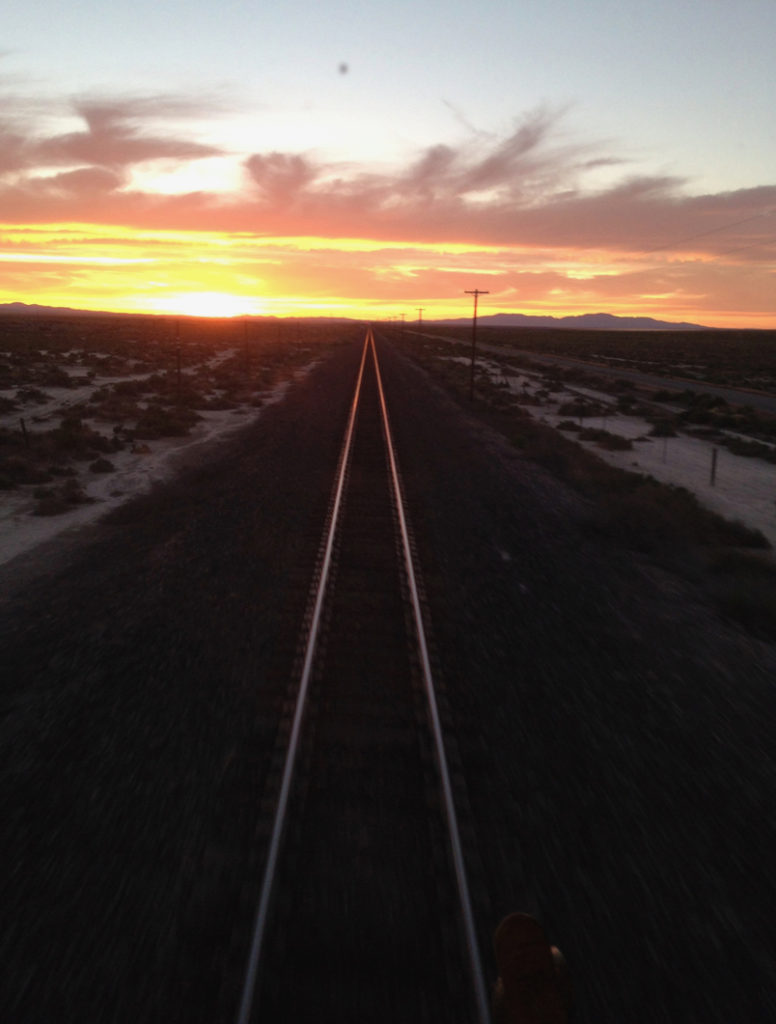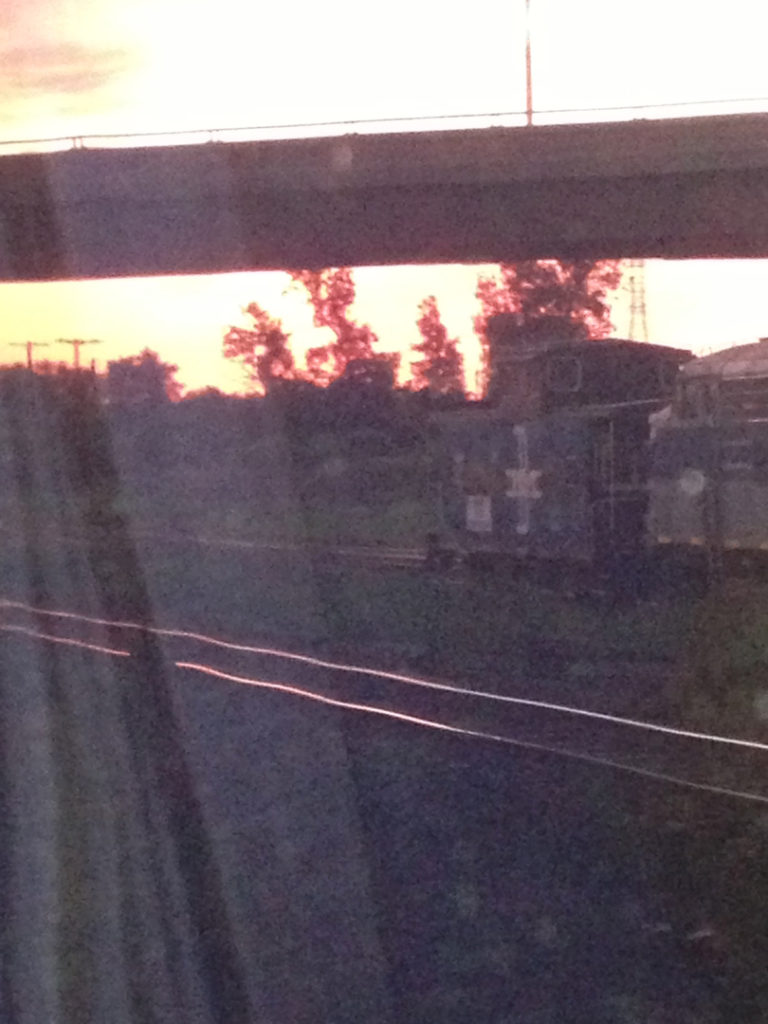Day for Night: Love of Train
Amtrak’s California Zephyr heads east through Palisade, Colo., in June 2011.
“Next time you throw a train, invite me.” — Janis Joplin
Next time you hear a train, visit Day for Night at the Bandcamp store! — Day for Night
My earliest train memory
is very brief. I remember being placed in a dark upholstered seat, under dim yellow light, in a passenger coach in or around Augusta, Maine. The family Ford had died on a bridge and we took the train back to Portland. Those were the last years of passenger rail on the Maine Central Railroad, and I was 4 or 5 years old.
At some point in childhood I started reading Model Railroader magazine and even attempted to build a layout. It was pathetic. I had no money and no skills, and the trains never ran on the South Portland & Pacific. I envied my cousins, accomplished model railroaders who had a fine layout in the basement of their home in Bangor, accessed through a trapdoor in the side porch.
My family visited Boston sometimes and I was captivated by the subways, the smell of ozone and hot grease and dust, the screech of steel wheels on steel rails. I wanted to build a model subway layout with glass covering the tunnels. That never happened.
On a cold November morning in late 1968, my mother kindly brought me to the Grand Trunk railroad yard on India Street to see a steam locomotive. It was pulling a foliage excursion train to Island Pond, Vt.
I can’t remember if we saw the locomotive or not, but the rail yard seemed pretty serious, heavy rails dense on the ground and treacherous, shining and slick. A few years later I took that foliage train northwest a few times — behind diesel-electric locomotives, as steam was all done by then.
I love trains and I always have. In these days of encroaching old age, the reading that pleases me the most — after pop and country music history of the 20th century — is about trains. I observe each car of the freight trains that hold me up at grade crossings. At work and at home, I pause to listen when trains sound their horns, though there’s rarely any difference from one instance to the next. We get a particular thrill from hearing Amtrak’s Downeaster go calling through the woods behind our house.
Scenic views from our maiden voyage on the Zephyr. Hubley Archives.
But the love for trains is an uneasy love.
No one shames you for it, exactly, but there’s a comprehension gap at best and at worst, a kind of amused pity because one is waxing so romantic over something so, well, unromantic. Seen objectively, railroading can be a brutal business, physically and ethically.
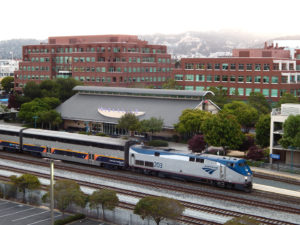
What better view from a hotel window on a hopeful early morning: the Amtrak station in Emeryville, Calif. Hubley Archives.
It’s easy to make a fool of a train lover (it’s a favorite pastime for Republicans in Congress). American passenger trains are slow at best and really slow at worst (see previous parenthetical comment). All that we train lovers ask of the train is a nice time, and so often what we get is a bus ride through New York state, eating sandwiches off our laps (2013, Lake Shore Limited).
So train lovers are an awkward minority, and I can say this as a member, although I don’t express my love by spending hours at trackside awaiting a photo opp nor by wearing an engineer’s cap and overalls to the model railroad expo.
One’s acquaintances may well express respect when one advocates for train travel over the pleasures of flying, long-distance driving or riding a bus. They say, “That’s so cool! I’d love to do that!”
But they never will, preferring to fly, drive all day or ride the bus.
Somewhere swampy on the way to Florida on the Silver Meteor. Hubley Archives.
I’m especially reluctant to enthuse about riding trains when I’m talking to one of those dry-humored, brusquely competent types who don’t let romance cloud their view of practical realities. These are good people to deal with when you’re trying to straighten out your E-ZPass account, but you still know they’ll smirk at you if you mention trains. (And a lot of them work on the trains. Railroad employees tend to call railroad fans “foamers,” as in foaming at the mouth with excitement at seeing a train. Mean!)
Steve, the trains still run. The fact that no one rides the truss rods anymore doesn’t mean trains aren’t relevant. Grabbing a train to flee a failed love affair is no less poignant because nowadays you can get a beer and Snickers to ease the sting — and it may be more poignant, because how pathetic is that? You want relevance? The Lac-Mégantic train tragedy has a distinctly 21st-century feel to it, wouldn’t you say?
At the same time, I will admit that writing about the Amtrak experience is really a challenge. I believe it’s possible to touch the soul with a song set on the Northeast Regional — the name alone is poetry — but it took years to make it happen:
(In 2016 we flew to Emeryville, Calif., for the sole purpose of riding Amtrak’s California Zephyr all the way back to Chicago, whence we rode the Lake Shore Limited all the way back to Boston, whence we had to settle for the bus to Portland because the LSL was so late.)
The Zephyr takes it slow around a curve in the Sierra Nevada. Hubley Archives.
Always a personal imperative, the train became something of a musical haven for us in 2011. Our first train trip to the West was a mind-bending expedition that included a crossing of the Rockies and visits to Grand Junction, the Colorado National Monument and little Palisade, land of wine grapes, cherries and peaches.
The roomette has two facing seats so you can see your partner. Between the seats you can unfold a table to hold your lyric sheets and snacks (for us, M&M peanuts) and booze (Jack Daniels). There’s not much room otherwise — unpacking an instrument can be awkward — but there’s enough. (Suggested additional viewing: the documentary Festival Express.)
There’s a big window so you can see western Massachusetts woods, Chicago warehouses, Iowa cornfields and Rocky Mountains going by; and there’s interior glass facing the corridor so you can observe humanity going by should you choose to leave the curtains open. The interior glass lets enough sound pass to inform the neighbors that there are cool musicians nearby, but not enough to create a public nuisance.
In 2011, we rode the Downeaster to Boston, the LSL to Chicago and the Zephyr out to Grand Junction, Colo., on the Utah border. It was on the LSL that we first played music on a train, establishing the routine we’ve observed ever since: tiny instruments, booze and snacks, passers-by swaying down the unsteady corridor, the world’s fascinations speeding past to be savored or ignored.
And what an intimate way to play music: acoustically, bodily, hedonically, geographically intimate. If you love trains and love music, how could it get any better? It’s not exactly nirvana — too many stimuli — but it’s certainly a kind of bliss where all good things are present for you, and your only responsibility is to be receptive to them (and to show your ticket when the conductor asks for it. And to not be a jerk).
At night the roomette seats convert to little beds, one up, one down. It’s not the best sleep in terms of becoming rested, but it does add another dimension, a psychic Instagram filter, to the unique phenomenological experience that is long-distance train travel. The whistle howls, dull fluorescent platform lights shine in your face during station stops in the wee small hours, the whistle howls, the train motion is back and forth, up and down, side to side; the whistle howls.
Then you get up, feel the full glory of introversion during an awkward breakfast with strangers in the dining car, and return to your little world behind glass, free to read, write, make music or just become one with the passing world.
My love of trains, like any thought pattern imprinted early on, is hard to explain. I love trains because I have always loved trains, which isn’t much of a reason aside from being true. Perhaps this explains the challenge of capturing the appeal of trains in a song, especially while you’re sitting around for five hours, with no end in sight and no information from Amtrak, in the Rensselaer railroad station.
And taking a sleeping accommodation, as we often do, provides still another benefit that, similar to the way caffeine enhances the effects of aspirin, heightens all the pleasures of the train: privacy.
Gretchen and I are a reclusive and introverted couple who, it seems, move through the world at all times in a virtual train compartment of mutual interests and fascinations, not least with one another. The Amtrak roomette is not just the conveyance of choice, but a perfect metaphor for us.
Enjoy some train songs from the Day for Night archives.
- Mr. Engineer (Jimmy Martin-Paul Williams) We first heard Jimmy Martin perform this on the “Trains” episode of Bob Dylan’s Theme Time Radio Hour. On that same episode we also heard (and subsequently learned) “Train of Love” by Johnny Cash. Louis Armstrong’s “2:19 Blues” is still out there waiting for us. From an October 2013 performance at the Royal Bean, Yarmouth. Songs of Universal, Inc.
- I Remember the Railroad (Gene Clark) I have loved this song since I first got my mitts on Gene Clark’s LP Roadmaster in 1977, but thought it was too much of a dirge to perform. Not so, as this 2011 living room performance suggests. Irving Music, Inc.
- What the Train Can Do For You (Hubley) A few years ago, Amtrak offered to heap riches and fame on someone who could show that whatever they wrote on a train trip would rise to glory on social media. I entered the contest and got nowhere, thanks to my minuscule social media presence. But the experience provoked me to finish a song about the emotional benefits of train riding. From a September 2019 rehearsal.
- (Waiting For A) Westbound Train (Hubley) Inspired by a conductor’s announcement on Amtrak’s Lake Shore Limited, I wrote this on the back porch of a cabin at the Chautauqua in Boulder, Colo., in June 2019. The conductor said we were stopped to wait for an eastbound train, but between the alliteration, which is nothing to be sneezed at in songwriting, and the fraught and many-layered symbolism of East vs. West in the American mythology, I had to bend the facts in this song to suit the reality. “We’re headed back East as we always must be / To the same old and the good old and the old used-to-be.” From a September 2019 rehearsal.
“What The Train Can Do For You” copyright © 2018 by Douglas L. Hubley. “(Waiting For A) Westbound Train” copyright © 2019 by Douglas L. Hubley. Text and “Hubley Archives” images copyright © 2017 by Douglas L. Hubley. All rights reserved.
